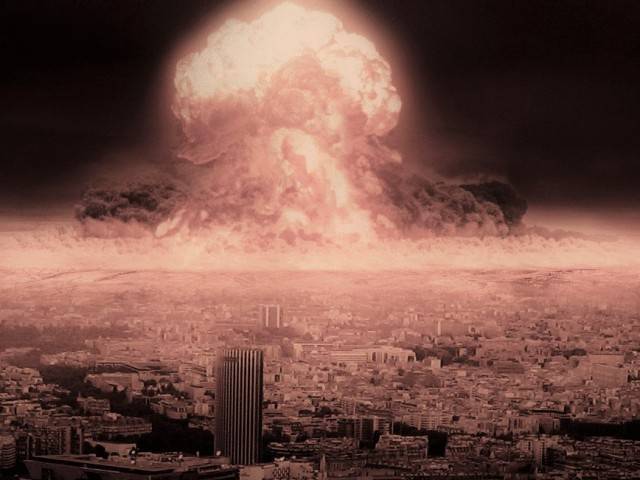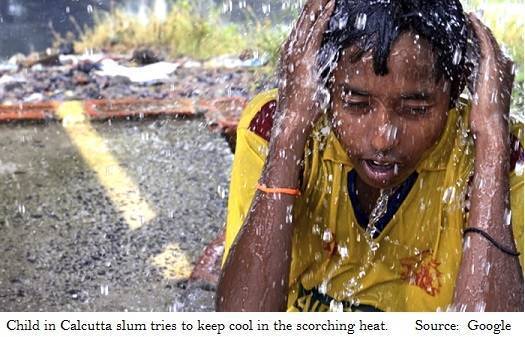Calcutta Scorched by Climate Detonation

“This much is clear: the climate has changed. Pre-monsoon rains, which tended to occur in brief sporadic showers to break the heat of summer, have been virtually non-existent since last year. In the last ten years they’ve become lighter and less frequent.”
SB VEDA
CALCUTTA – A typical April day in Calcutta is known to be sweltering. With that in mind, on Thursday, April 7th, as the mercury crossed forty
(five degrees above normal) Susavan Sarkar still boarded a minibus at Rajabazar in the centre of the city. It was a matter of routine for the fifty-one year old resident of MG Road. Bound for Behala in the south, some fifteen minutes later, he noticed something strange at the AJC Bose Flyover near Chowringee: goose bumps started to form even as sweat streamed off of his skin. He became nauseas, the other passengers spinning before his eyes. Moments later, he was seen crashing to the floor. Words flung at the last minute had alerted fellow commuters to his distress as the light shut out around him.
He likely didn’t know it but his body’s cooling system had been short-circuited. He was sweating so much, parts of him were cooling down too quickly. As air from the windows struck his extremities, they became cold, tricking his body into generating warmth in the form of goose bumps and chills. This, despite the fact that his organs were overheating. Unwittingly his own temperature control system had begun the process of stewing his body’s own organs, for such is the fatal irony of heat-stroke.
Sarkar was taken to SSKM Hospital in Sealdah only three and a half kilometres from where he collapsed but doctors pronounced him dead on arrival: another striking example of how, once the body’s cooling system goes in reverse, death can be imminent.
While it is not unusual for landlocked cities like Delhi to experience such heat, it is rare to have temperatures above 40 Degrees Celsius in Calcutta. Some light drizzle came on the day Sarkar died, and so, anticipating it being a one-off, people relaxed; for, surely the moisture would dampen the rising mercury.
The regional meteorological office (or Met Office as it’s known) concurred, forecasting relief after reporting isolated rain in parts of south Bengal. It even declared thunderstorms as being imminent for Kolkata, Howrah, Hooghly and Malda. “The coastal areas, also under the ongoing heat wave over the last few days due to lack of sea breeze blowing over them, also cooled down a little after spells of rain yesterday night,” said the weather office.
As the heat continued, they hinted at better times ahead: “There is still time for nor’wester to enter Bengal. There is a nor’wester forcast for Odisha which may enter West Bengal after hitting the coastal state,” said a met official.
Only the rain didn’t come and the temperatures kept going up.
Summer detonated like an atom bomb through the weekend and the sun’s radiation scorched the Earth into the next week. By April 12th, it reached 41.3 degrees, the hottest day in 36 years and only two degrees lower than the all-time record, which occurred in 1954.
The unprecedented heat caused Chief Minister Mamata Banerjee to act, ordering school closures and issuing warnings. But ordinary people were compelled to go on. So, Tuesday’s heat claimed another victim.
This time it was a sixty year old man at Garia Railway station on the city’s southern fringes. Elsewhere in the state, three others had already died.
Incredibly, Calcutta was not the center of the heat wave. Other places were even hotter: Birbhum soared to forty-two degrees, and Bankura to an astonishing forty-five.
A COUNTRY-WIDE TREND
South of West Bengal, the situation has been even worse. In Andra Pradesh and Telengana over a hundred have died, already.
The Indian Meteorological Department has reported temperatures higher than normal in parts of western Uttar Pradesh, Delhi, eastern Rajasthan and parts of Madhya Pradesh as well.
The Western state of Maharashtra has been facing a drought-like situation due to two successive poor monsoons. People in Marthwara, in particular, have barely any drinking water and officials say dams in the region are left with just five per cent of water ahead of the summer season.
Last year, the heat claimed over 2,000 lives country-wide. What is truly frightening about the current year’s heat wave is that last year, despite the massive number of deaths, it still wasn’t this hot. It leaves many to wonder what lies ahead? Summer has only just begun.
This much is clear: the climate has changed.
Pre-monsoon rains, which tended to occur in brief sporadic showers to break the heat of summer, have been virtually non-existent since last year. In the last ten years they’ve become lighter and less frequent. Also, monsoons, while causing flooding in some places have been poor in others. It should come as no surprise. After all, where would the moisture come from when green spaces in India are being depleted at such an alarming rate.
This magazine reported in January on the depletion of Wetlands in India and its impact during monsoons. At the time, India’s most prominent ecologist and United Nations 500 Laureate remarked on the loss of green space as contributing to hotter weather.
“The EKW (East Kolkata Wetlands) provides moisture and oxygen to the atmosphere, which acts as a natural cooling mechanism for the city; and the more it is encroached upon, the more will there be loss of this natural cooling capacity, said Ghosh.
To a lesser degree, urban forestry offers such a natural cooling mechanism. The TMC government in West Bengal is known to be in support of urban greening even as it permits depletion green spaces around the city. “It’s being penny-wise and pound foolish,” said Ghosh.
“In fact it’s more dangerous to plant a tree along the side of a road on increasingly dry Earth. Where will the roots grow? The tree will surely fall, potentially causing injury, damage or death. But this is the foolish logic of the powers that be: for the city, do a make-over and for the climate, do a take-over! he said.
It used to be that the greenery of Tollygunge created a microclimate, so the southern part of the city was a degree or two cooler than the centre. This year, no difference has been observed. The microclimate of the southern part of the city has perhaps been decimated.
Still, Calcutta has more greenery than other Indian cities. Despite India’s National Building Code specifying that there should be at least 4 acres of open spaces, accessible to all, per 1,000 population (roughly 16 sq m. per capita). Mumbai has less than one-hundredth of that – a pitiful 0.03 acres. And yet the Indian standard is considered backward by ecologists. Most developed nations use a standard of 40 sq. m. per capita that for urban green space more, and require this to be balanced by suburbs with 140 sq. m per capita. And yet despite India’s lower standard on urban green space, her cities are failing it, miserable.
As astonishing as the heat has been, in view of the overwhelming scientific evidence of climate change, it is perhaps more astonishing that people question why it is getting hotter.
URBAN WARMING IS TO GLOBAL WARMING WHAT THE ORGANS ARE TO THE BODY
What about CFCs? The Ozone layer? Global Climate change? – You might ask? Well, it’s all related. In cities, especially mega-cities (those with population of over 10 Million such as Calcutta, Mumbai and Delhi) urban (and, more importantly, sub-urban) green space is critical to the maintenance of a relatively stable weather patterns over time.
While Cities occupy less than three percent of the global terrestrial surface, they account for seventy eight percent of carbon emissions, sixty percent of residential water use, and seventy six percent of wood used for industrial purposes. And, the metrics can be said to be maximum in the Megacities. This means that in these engines of economic activity, the greatest ‘burn’ is generated. That burn must be mitigated if the cities are to survive long-term (or be ‘resilient’ as the popular new catchphrase for sustainability connotes).
So, if cities cannot cool down, sufficiently at their core areas of heat generation, their organs, if you will, the natural preservation systems will be short-circuited in much the same way as poor Mr. Sarkar’s body’s did. And then, cities will heat up even further. How high can temperatures go? It’s reasonable to say that nobody knows with certainty just as you might not know when your own body’s temperature regulation system might fail.
We are left begging the question, can a city suffer from heat-stroke? It’s the notion of a metropolis becoming so overcome by its own change in climate that it becomes it begins to die as a habitat.
Unless the environment is prioritized above even hallowed ‘development goals’ this could well be just the beginning. The air conditioners may be humming in big houses and tall buildings – but on the streets people are being struck down. Many more are sure to die before the people in the cool buildings care to do something about it. By then, as for Mr. Sarkar, such realization may come dead on arrival.
 The Global Calcuttan Magazine
The Global Calcuttan Magazine 